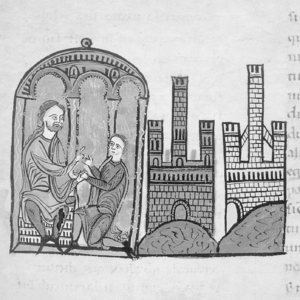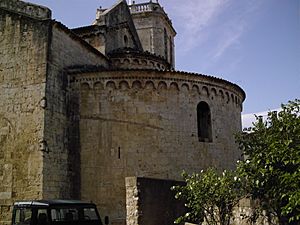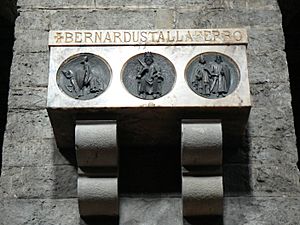Bernard I, Count of Besalú facts for kids
Quick facts for kids Bernard I, Count of Besalú |
|
|---|---|
 |
|
| Bernard giving his lands to his son, William, from an old book called Liber feudorum maior | |
| Spouse(s) | Toda (Adelaide) |
| Issue | |
| William, Wifred, Henry, Hugh, Berengar, Constance, Adelaide, Garsenda (possible) | |
| Noble family | House of Barcelona |
| Father | Oliba Cabreta |
| Mother | Ermengard of Empúries |
| Died | 1020 River Rhône |
| Burial | Monastery of Santa Maria de Ripoll |
Bernard I (lived around 977 – 1020), also known as Taillefer (meaning "Iron-cutter" or "Iron-splitter" in Old French), was the Count of Besalú in Catalonia. He ruled from 988 until he died. Bernard was the oldest son of Oliba Cabreta and Ermengard of Empúries. He took over Besalú after his father. His younger brothers, Oliba and Wifred, inherited other areas like Berga and Cerdagne. Bernard was a great-grandson of Wilfred the Hairy, a very important figure in Catalan history. This meant he was part of the powerful House of Barcelona.
Contents
Early Life and Becoming Count
Bernard's first public appearance was when his father was still ruling. On April 12, 977, he and his mother watched as Miro II gave the church of Saint Vincent to the church of Besalú. Bernard also saw his parents give property to Sant Llorenç de Bagà in 981, along with his brothers.
His father, Oliba Cabreta, left his sons a very strong region. It was perhaps the most powerful in Catalonia at the time. Their family controlled many important monasteries. These included Ripoll, Cuixà, Sant Joan, and Banyoles.
Even though Bernard already had a son, William, he was still quite young when his father became a monk in 988. Bernard and his brother Wifred were placed under the protection of Pope John XV. Bernard inherited Besalú, along with lands in Fenouillèdes and Peyrepertuse. These areas were in the County of Carcassonne, where his father had expanded their family's power. Bernard also inherited Vallespir after his mother died, which happened after 994.
Working with the Church
Bernard's family did not control a bishopric at first. But Bernard and his brothers quickly worked to change this. His younger brother, Berengar, became Bishop of Elne in 993. Another brother, Oliba, left his county to become a monk in 1003. He later became Bishop of Vic in 1018. Bernard and Wifred also paid a lot of money to make Wifred's son, also named Wifred, the Archbishop of Narbonne in 1016.
In 998, Bernard went on a pilgrimage to Rome with Ermengol I of Urgell. They attended a church meeting led by Emperor Otto III. In 1016–17, Bernard went to Rome again with a large group. This group included his sons, his brother Oliba, and many important church leaders. They celebrated Christmas at Saint Peter's Basilica.
While in Rome, Bernard asked Pope Benedict VIII to create a new bishopric in Besalú. He also accused the nuns of Sant Joan of bad behavior. Because they refused to appear before the Pope, Benedict closed their convent. He replaced them with monks and gave Bernard control over the abbey's payments. The Pope then created the new bishopric Bernard wanted. Bernard paid to have his second son, Wifred, installed as the new bishop. Even though Wifred was young, the Pope himself made him a bishop. Bernard chose Besalú as the main seat for the new bishopric.
Bernard brought back a piece of the Holy Cross from Rome. He placed it in the church of Sant Pere in Besalú. This church already had altars dedicated to other saints.
Around 1000, Bernard started a monastery at Sant Pau. In 1003, he moved the monks from Sant Aniol d'Aguja to Sant Llorenç del Mont. The church of Sant Pere in Besalú, which was rebuilt in a Romanesque style, was officially opened by Bernard on September 23, 1003.
Bernard had a unique relationship with the Church. In his court rulings in 1002 and 1004, the list of people who agreed with the decisions started with four abbots. This shows how important monasteries were in Besalú at that time. In a document from 1017, Bernard said the Pope held power over the world. But he also added that "no one, not even the Pope himself, nor a General Council, can break the rules of this document." This showed his independent spirit.
Military Actions
In 1003, Bernard joined a "holy war" to fight an invading army from the Córdoba. They defeated the army in a battle near Thoranum castrum. Bernard seemed to be the main leader among the Catalan forces. The Córdoban army went back to their own land. There was a second battle at Albesa, but the outcome is not clear. Bernard's brother Berengar died there.
When Giselbert I of Roussillon died in 1014, his brother Hugh I of Empúries tried to take over the County of Roussillon. Giselbert's young son, Gausfred II, asked Bernard and Oliba for help. With their help, Hugh and Gausfred reached an agreement in 1020.
How Bernard Ruled
In 1005, Bernard started using the title "prince" (princeps). This title meant "sovereign" or "ruler" at the time. His brother Oliba later called him "sovereign and father of his country." Oliba also praised Bernard for his fair judgments. In 1015, Bernard began using the title "duke" (dux). This title suggested he was a military leader, but it did not mean he was trying to be a king.
During Bernard's rule, people still used old laws from the Visigoths and the court system set up by the Carolingians. But there were also new legal ways of doing things. Bernard even made his own money, but no examples of his coins have survived. Later coins made by his grandson, Bernard II, show a cross. This cross represents the piece of the Holy Cross that Bernard I brought back from Rome.
Bernard was also the first Catalan count to have his own seal. He copied the style of the Carolingian emperors and Frankish kings. Even though these kings were his official rulers, having his own seal showed that Bernard had full power in his own lands.
Family and Death
In 992, Bernard married a woman named Toda, who was also called Adelaide. Old documents confirm this. A gift of property in 1000 mentions "my wife Toda who they call Adelaide." Another gift in 1018 mentions "my wife, the countess Toda, who is called Adelaide." They often gave gifts to the church of Santa Maria del Castell de Besalú. Toda is not mentioned after Bernard's will was written.
Bernard drowned in the Rhône river in 1020 while crossing into the County of Provence. He was buried in the monastery of Santa Maria de Ripoll.
Bernard's will, written on September 26, 1020, listed his children: Henry, Hugh, Berengar, Adelaide, Constance, and William. It also named his wife and his brother Oliba. His will was later made public by his widow, his brother Oliba, his son Wifred, and three other helpers. This version also named his daughters and added his brother Wifred and his nephew, Raymond I.
Bernard left his younger sons under the care of their older brother William, who inherited Besalú. His second son, Wifred, was already the bishop of Besalú. Bernard named his third son, Henry, as Wifred's heir in the church. William had to pay for Henry to become a bishop. Bernard's two youngest sons, Hugh and Berengar, received lands on the borders of the county. They were called "co-heirs," but they were mostly local lords and loyal to their older brother.
Bernard's oldest daughter, Constance, received several lands in his will. She might be the Constance who married Count Ermengol II of Urgell. This marriage would have helped strengthen ties between Besalú and Urgell. Another of Bernard's daughters, Adelaide, married Ponç I of Empúries. After her husband died, she became a nun at the monastery of Sant Pau. A possible daughter named Garsenda, who was not named in his will, married Berengar, the viscount of Narbonne.
Images for kids
-
Bernard giving his lands to his son, William, from an old book called Liber feudorum maior
See also
 In Spanish: Bernardo I de Besalú para niños
In Spanish: Bernardo I de Besalú para niños






